2023 HYUNDAI SANTA CRUZ under seat
[x] Cancel search: under seatPage 333 of 598
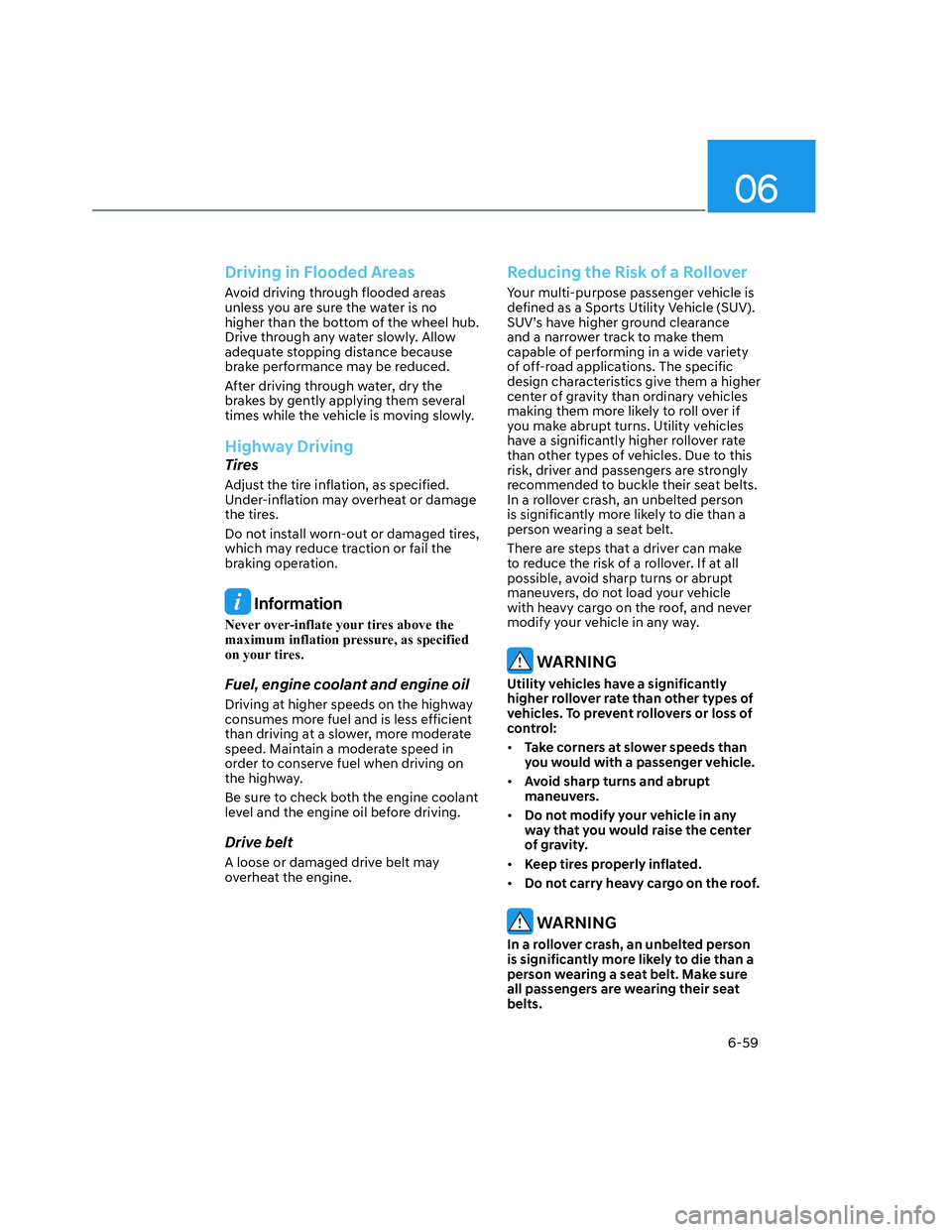
06
6-59
Driving in Flooded Areas
Avoid driving through flooded areas
unless you are sure the water is no
higher than the bottom of the wheel hub.
Drive through any water slowly. Allow
adequate stopping distance because
brake performance may be reduced.
After driving through water, dry the
brakes by gently applying them several
times while the vehicle is moving slowly.
Highway Driving
Tires
Adjust the tire inflation, as specified.
Under-inflation may overheat or damage
the tires.
Do not install worn-out or damaged tires,
which may reduce traction or fail the
braking operation.
Information
Never over-inflate your tires above the
maximum inflation pressure, as specified
on your tires.
Fuel, engine coolant and engine oil
Driving at higher speeds on the highway
consumes more fuel and is less efficient
than driving at a slower, more moderate
speed. Maintain a moderate speed in
order to conserve fuel when driving on
the highway.
Be sure to check both the engine coolant
level and the engine oil before driving.
Drive belt
A loose or damaged drive belt may
overheat the engine.
Reducing the Risk of a Rollover
Your multi-purpose passenger vehicle is
defined as a Sports Utility Vehicle (SUV).
SUV’s have higher ground clearance
and a narrower track to make them
capable of performing in a wide variety
of off-road applications. The specific
design characteristics give them a higher
center of gravity than ordinary vehicles
making them more likely to roll over if
you make abrupt turns. Utility vehicles
have a significantly higher rollover rate
than other types of vehicles. Due to this
risk, driver and passengers are strongly
recommended to buckle their seat belts.
In a rollover crash, an unbelted person
is significantly more likely to die than a
person wearing a seat belt.
There are steps that a driver can make
to reduce the risk of a rollover. If at all
possible, avoid sharp turns or abrupt
maneuvers, do not load your vehicle
with heavy cargo on the roof, and never
modify your vehicle in any way.
WARNING
Utility vehicles have a significantly
higher rollover rate than other types of
vehicles. To prevent rollovers or loss of
control:
• Take corners at slower speeds than
you would with a passenger vehicle.
• Avoid sharp turns and abrupt
maneuvers.
• Do not modify your vehicle in any
way that you would raise the center
of gravity.
• Keep tires properly inflated.
• Do not carry heavy cargo on the roof.
WARNING
In a rollover crash, an unbelted person
is significantly more likely to die than a
person wearing a seat belt. Make sure
all passengers are wearing their seat
belts.
Page 498 of 598
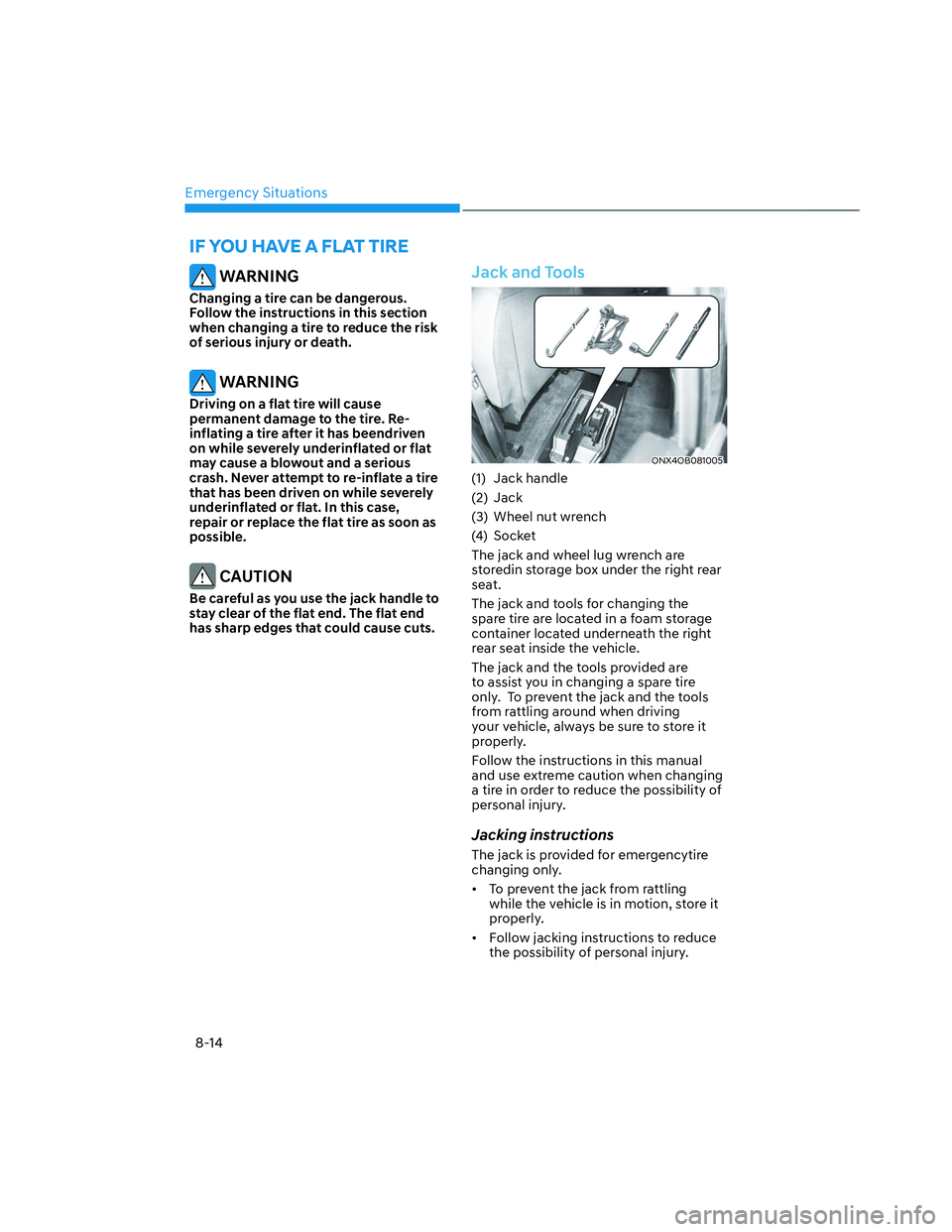
Emergency Situations
8-14
IF YOU HAVE A FLAT TIRE
WARNING
Changing a tire can be dangerous.
Follow the instructions in this section
when changing a tire to reduce the risk
of serious injury or death.
WARNING
Driving on a flat tire will cause
permanent damage to the tire. Re-
inflating a tire after it has beendriven
on while severely underinflated or flat
may cause a blowout and a serious
crash. Never attempt to re-inflate a tire
that has been driven on while severely
underinflated or flat. In this case,
repair or replace the flat tire as soon as
possible.
CAUTION
Be careful as you use the jack handle to
stay clear of the flat end. The flat end
has sharp edges that could cause cuts.
Jack and Tools
ONX4OB081005ONX4OB081005
(1) Jack handle
(2) Jack
(3) Wheel nut wrench
(4) Socket
The jack and wheel lug wrench are
storedin storage box under the right rear
seat.
The jack and tools for changing the
spare tire are located in a foam storage
container located underneath the right
rear seat inside the vehicle.
The jack and the tools provided are
to assist you in changing a spare tire
only. To prevent the jack and the tools
from rattling around when driving
your vehicle, always be sure to store it
properly.
Follow the instructions in this manual
and use extreme caution when changing
a tire in order to reduce the possibility of
personal injury.
Jacking instructions
The jack is provided for emergencytire
changing only.
• To prevent the jack from rattling
while the vehicle is in motion, store it
properly.
• Follow jacking instructions to reduce
the possibility of personal injury.
Page 505 of 598
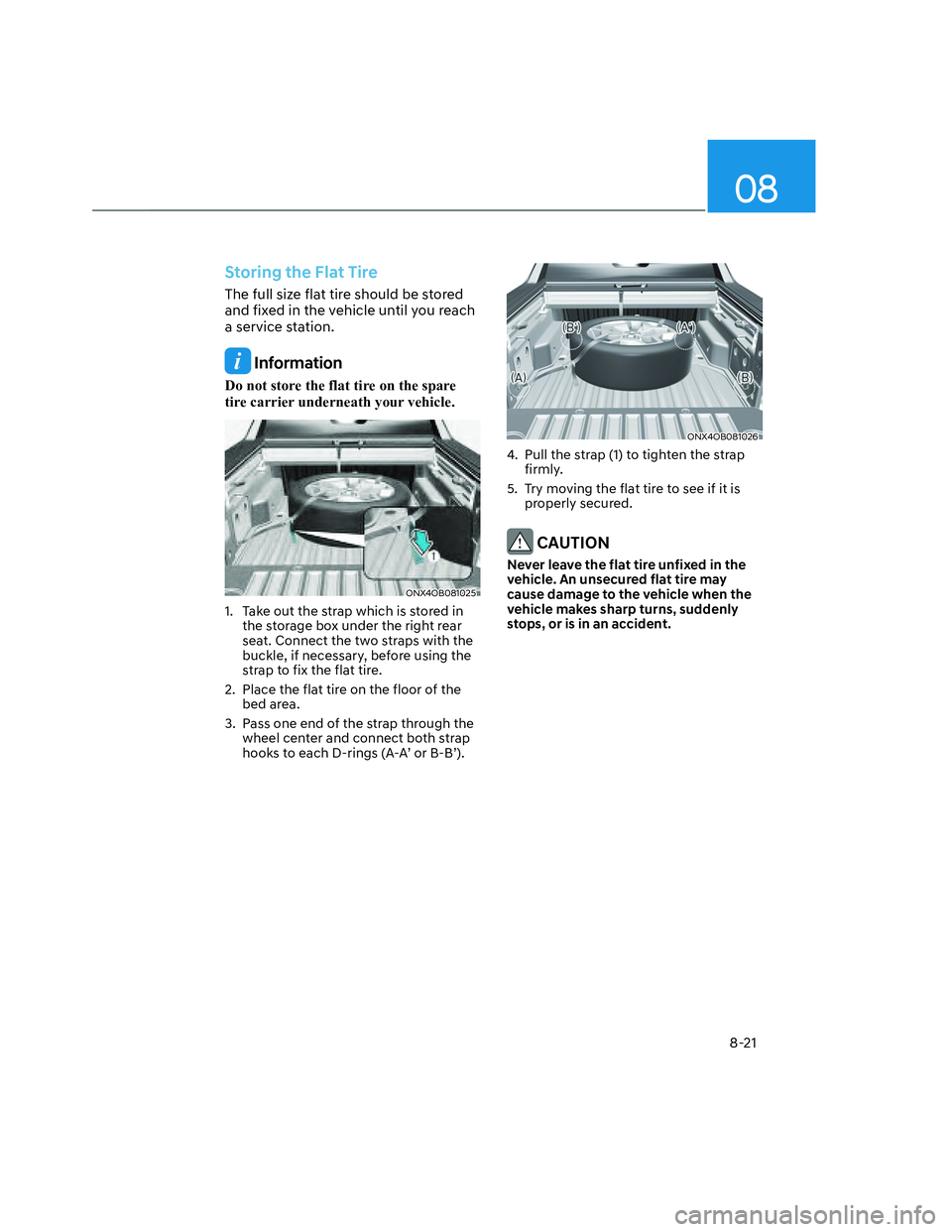
08
8-21
Storing the Flat Tire
The full size flat tire should be stored
and fixed in the vehicle until you reach
a service station.
Information
Do not store the flat tire on the spare
tire carrier underneath your vehicle.
ONX4OB081025ONX4OB081025
1. Take out the strap which is stored in
the storage box under the right rear
seat. Connect the two straps with the
buckle, if necessary, before using the
strap to fix the flat tire.
2. Place the flat tire on the floor of the
bed area.
3. Pass one end of the strap through the
wheel center and connect both strap
hooks to each D-rings (A-A’ or B-B’).
ONX4OB081026ONX4OB081026
4. Pull the strap (1) to tighten the strap
firmly.
5. Try moving the flat tire to see if it is
properly secured.
CAUTION
Never leave the flat tire unfixed in the
vehicle. An unsecured flat tire may
cause damage to the vehicle when the
vehicle makes sharp turns, suddenly
stops, or is in an accident.
Page 514 of 598
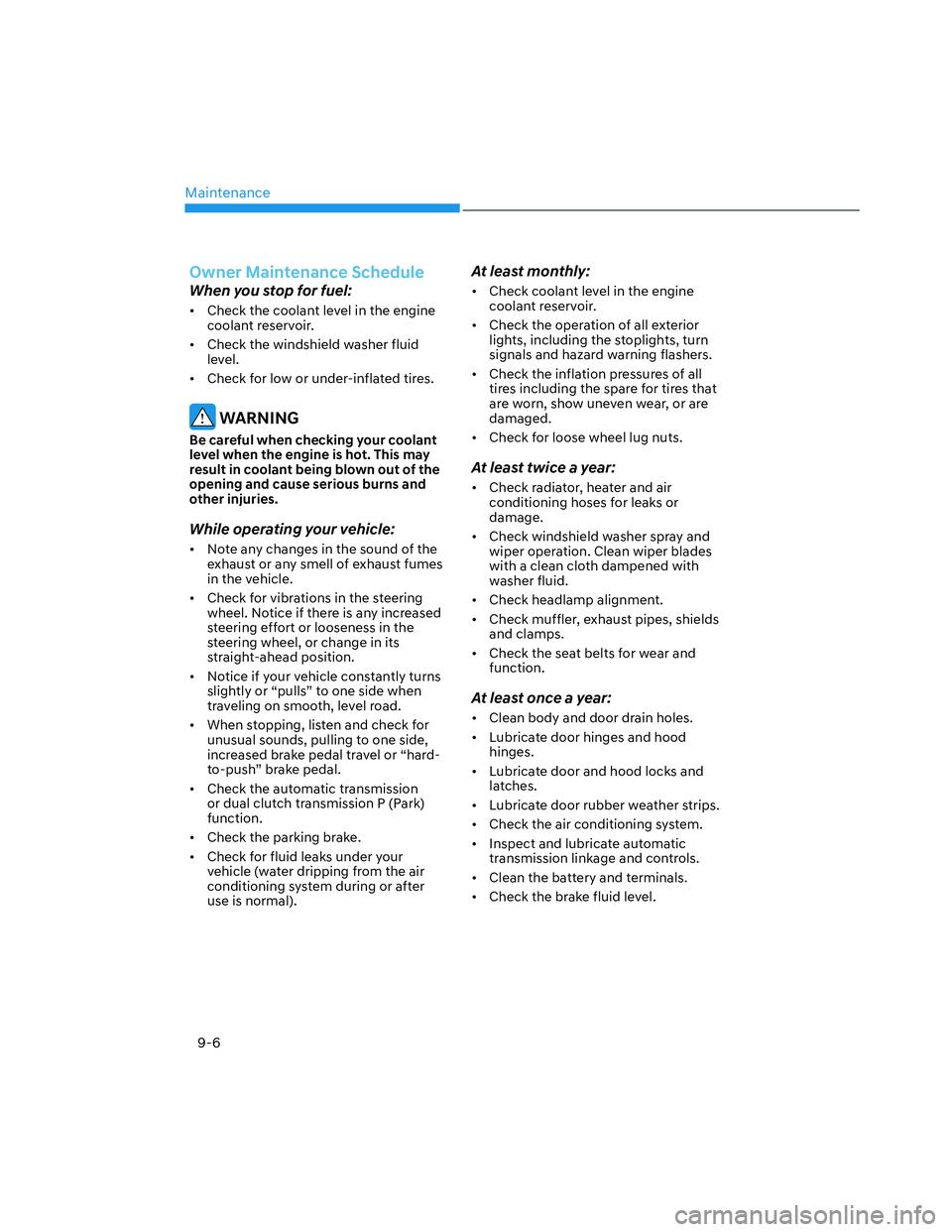
Maintenance
9-6
Owner Maintenance Schedule
When you stop for fuel:
• Check the coolant level in the engine
coolant reservoir.
• Check the windshield washer fluid
level.
• Check for low or under-inflated tires.
WARNING
Be careful when checking your coolant
level when the engine is hot. This may
result in coolant being blown out of the
opening and cause serious burns and
other injuries.
While operating your vehicle:
• Note any changes in the sound of the
exhaust or any smell of exhaust fumes
in the vehicle.
• Check for vibrations in the steering
wheel. Notice if there is any increased
steering effort or looseness in the
steering wheel, or change in its
straight-ahead position.
• Notice if your vehicle constantly turns
slightly or “pulls” to one side when
traveling on smooth, level road.
• When stopping, listen and check for
unusual sounds, pulling to one side,
increased brake pedal travel or “hard-
to-push” brake pedal.
• Check the automatic transmission
or dual clutch transmission P (Park)
function.
• Check the parking brake.
• Check for fluid leaks under your
vehicle (water dripping from the air
conditioning system during or after
use is normal).
At least monthly:
• Check coolant level in the engine
coolant reservoir.
• Check the operation of all exterior
lights, including the stoplights, turn
signals and hazard warning flashers.
• Check the inflation pressures of all
tires including the spare for tires that
are worn, show uneven wear, or are
damaged.
• Check for loose wheel lug nuts.
At least twice a year:
• Check radiator, heater and air
conditioning hoses for leaks or
damage.
• Check windshield washer spray and
wiper operation. Clean wiper blades
with a clean cloth dampened with
washer fluid.
• Check headlamp alignment.
• Check muffler, exhaust pipes, shields
and clamps.
• Check the seat belts for wear and
function.
At least once a year:
• Clean body and door drain holes.
• Lubricate door hinges and hood
hinges.
• Lubricate door and hood locks and
latches.
• Lubricate door rubber weather strips.
• Check the air conditioning system.
• Inspect and lubricate automatic
transmission linkage and controls.
• Clean the battery and terminals.
• Check the brake fluid level.
Page 551 of 598
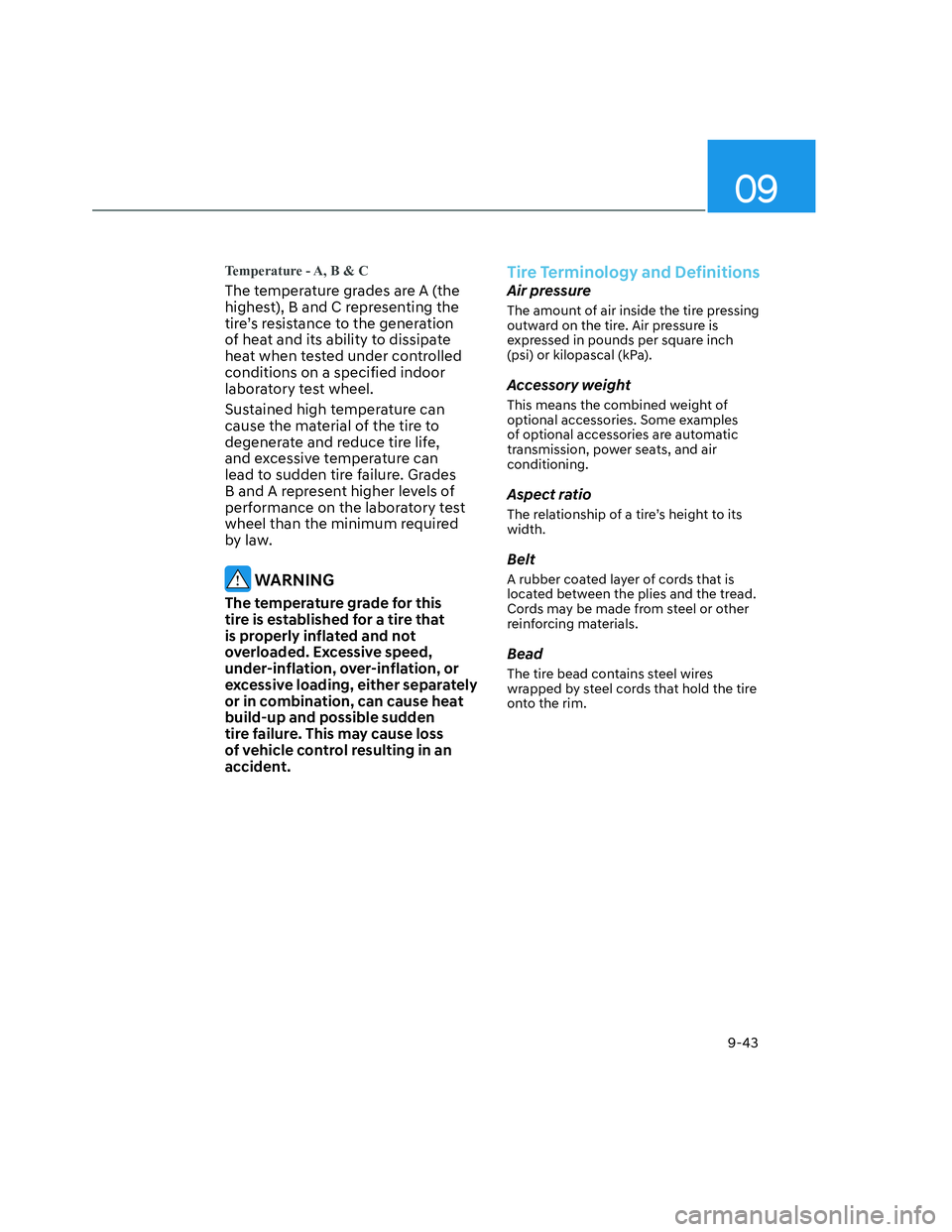
09
9-43
Temperature - A, B & C
The temperature grades are A (the
highest), B and C representing the
tire’s resistance to the generation
of heat and its ability to dissipate
heat when tested under controlled
conditions on a specified indoor
laboratory test wheel.
Sustained high temperature can
cause the material of the tire to
degenerate and reduce tire life,
and excessive temperature can
lead to sudden tire failure. Grades
B and A represent higher levels of
performance on the laboratory test
wheel than the minimum required
by law.
WARNING
The temperature grade for this
tire is established for a tire that
is properly inflated and not
overloaded. Excessive speed,
under-inflation, over-inflation, or
excessive loading, either separately
or in combination, can cause heat
build-up and possible sudden
tire failure. This may cause loss
of vehicle control resulting in an
accident.
Tire Terminology and Definitions
Air pressure
The amount of air inside the tire pressing
outward on the tire. Air pressure is
expressed in pounds per square inch
(psi) or kilopascal (kPa).
Accessory weight
This means the combined weight of
optional accessories. Some examples
of optional accessories are automatic
transmission, power seats, and air
conditioning.
Aspect ratio
The relationship of a tire’s height to its
width.
Belt
A rubber coated layer of cords that is
located between the plies and the tread.
Cords may be made from steel or other
reinforcing materials.
Bead
The tire bead contains steel wires
wrapped by steel cords that hold the tire
onto the rim.
Page 554 of 598
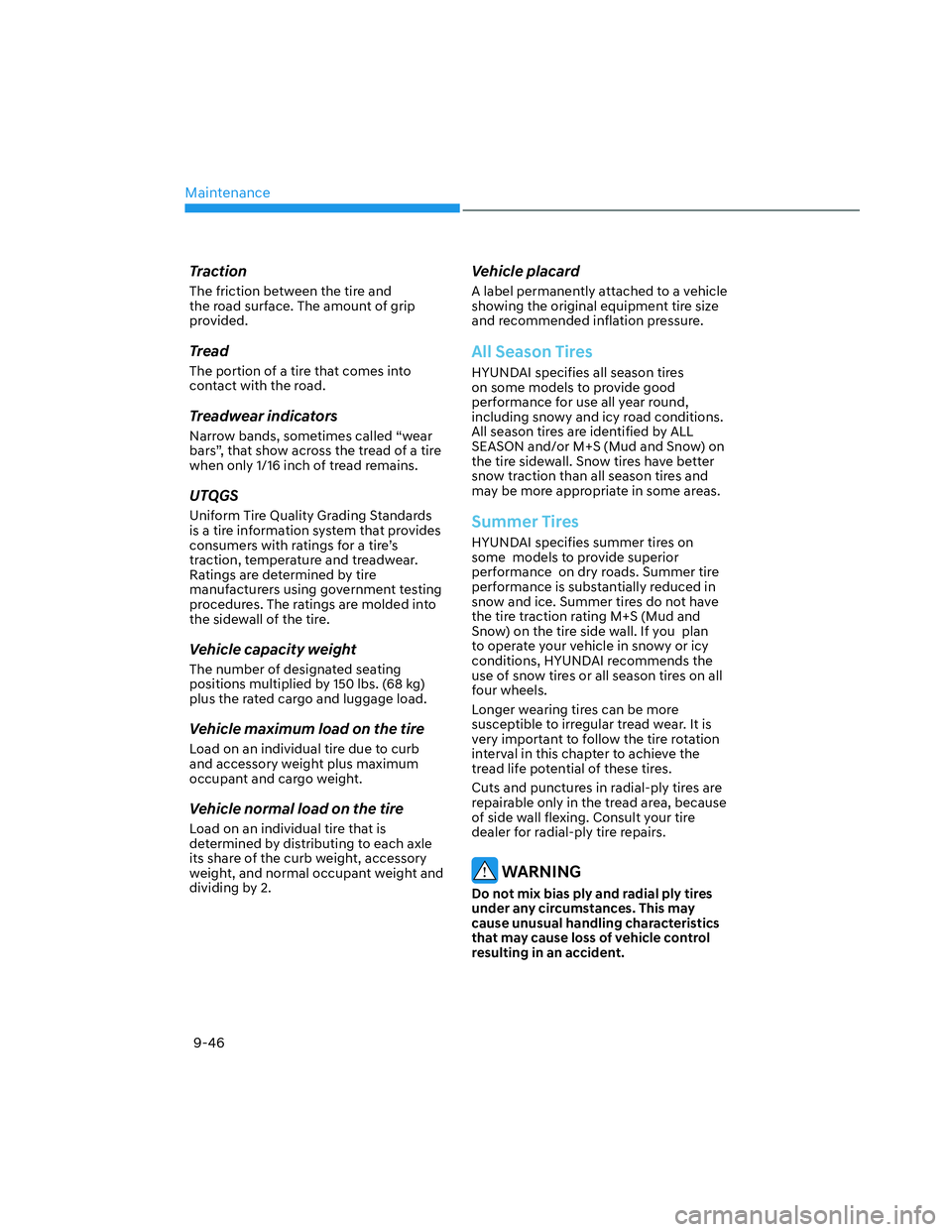
Maintenance
9-46
Traction
The friction between the tire and
the road surface. The amount of grip
provided.
Tread
The portion of a tire that comes into
contact with the road.
Treadwear indicators
Narrow bands, sometimes called “wear
bars”, that show across the tread of a tire
when only 1/16 inch of tread remains.
UTQGS
Uniform Tire Quality Grading Standards
is a tire information system that provides
consumers with ratings for a tire’s
traction, temperature and treadwear.
Ratings are determined by tire
manufacturers using government testing
procedures. The ratings are molded into
the sidewall of the tire.
Vehicle capacity weight
The number of designated seating
positions multiplied by 150 lbs. (68 kg)
plus the rated cargo and luggage load.
Vehicle maximum load on the tire
Load on an individual tire due to curb
and accessory weight plus maximum
occupant and cargo weight.
Vehicle normal load on the tire
Load on an individual tire that is
determined by distributing to each axle
its share of the curb weight, accessory
weight, and normal occupant weight and
dividing by 2.
Vehicle placard
A label permanently attached to a vehicle
showing the original equipment tire size
and recommended inflation pressure.
All Season Tires
HYUNDAI specifies all season tires
on some models to provide good
performance for use all year round,
including snowy and icy road conditions.
All season tires are identified by ALL
SEASON and/or M+S (Mud and Snow) on
the tire sidewall. Snow tires have better
snow traction than all season tires and
may be more appropriate in some areas.
Summer Tires
HYUNDAI specifies summer tires on
some models to provide superior
performance on dry roads. Summer tire
performance is substantially reduced in
snow and ice. Summer tires do not have
the tire traction rating M+S (Mud and
Snow) on the tire side wall. If you plan
to operate your vehicle in snowy or icy
conditions, HYUNDAI recommends the
use of snow tires or all season tires on all
four wheels.
Longer wearing tires can be more
susceptible to irregular tread wear. It is
very important to follow the tire rotation
interval in this chapter to achieve the
tread life potential of these tires.
Cuts and punctures in radial-ply tires are
repairable only in the tread area, because
of side wall flexing. Consult your tire
dealer for radial-ply tire repairs.
WARNING
Do not mix bias ply and radial ply tires
under any circumstances. This may
cause unusual handling characteristics
that may cause loss of vehicle control
resulting in an accident.
Page 594 of 598
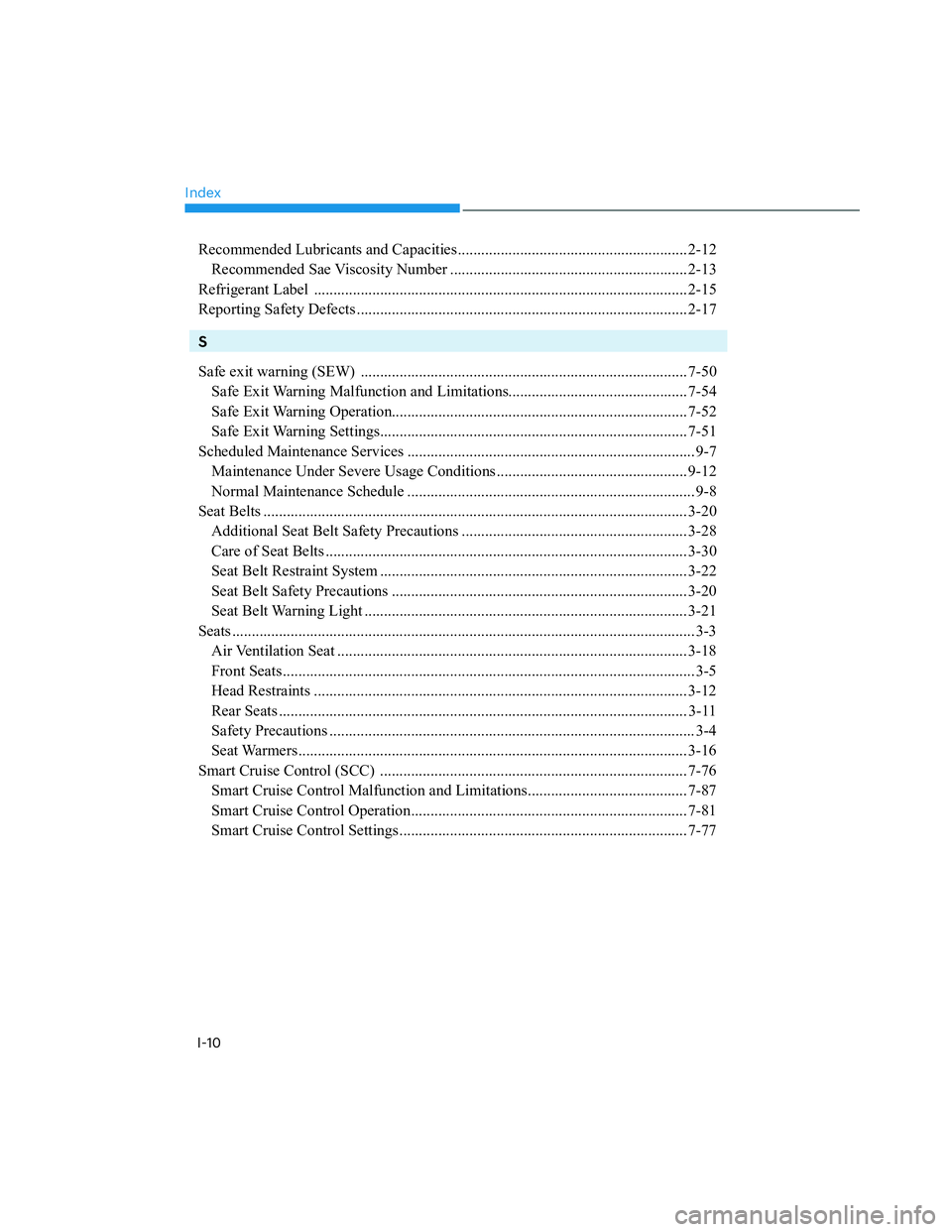
Index
I-10
Recommended Lubricants and Capacities........................................................... 2-12
Recommended Sae Viscosity Number ............................................................. 2-13
Refrigerant Label ................................................................................................ 2-15
Reporting Safety Defects ..................................................................................... 2-17
S
Safe exit warning (SEW) .................................................................................... 7-50
Safe Exit Warning Malfunction and Limitations.............................................. 7-54
Safe Exit Warning Operation............................................................................ 7-52
Safe Exit Warning Settings............................................................................... 7-51
Scheduled Maintenance Services .......................................................................... 9-7
Maintenance Under Severe Usage Conditions ................................................. 9-12
Normal Maintenance Schedule .......................................................................... 9-8
Seat Belts ............................................................................................................. 3-20
Additional Seat Belt Safety Precautions .......................................................... 3-28
Care of Seat Belts ............................................................................................. 3-30
Seat Belt Restraint System ............................................................................... 3-22
Seat Belt Safety Precautions ............................................................................ 3-20
Seat Belt Warning Light ................................................................................... 3-21
Seats ....................................................................................................................... 3-3
Air Ventilation Seat .......................................................................................... 3-18
Front Seats .......................................................................................................... 3-5
Head Restraints ................................................................................................ 3-12
Rear Seats ......................................................................................................... 3-11
Safety Precautions .............................................................................................. 3-4
Seat Warmers.................................................................................................... 3-16
Smart Cruise Control (SCC) ............................................................................... 7-76
Smart Cruise Control Malfunction and Limitations......................................... 7-87
Smart Cruise Control Operation....................................................................... 7-81
Smart Cruise Control Settings .......................................................................... 7-77
Page 595 of 598
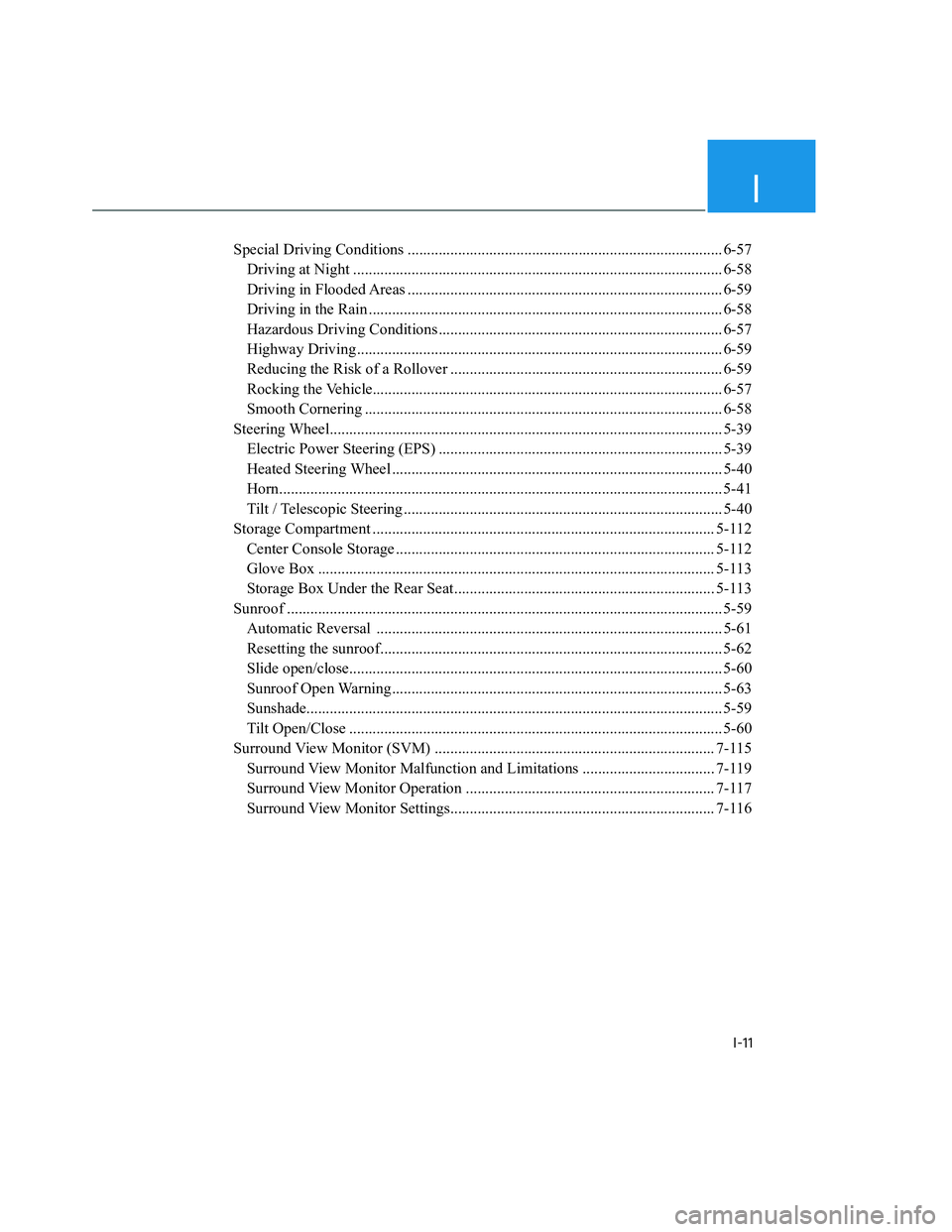
I
I-11
Special Driving Conditions ................................................................................. 6-57
Driving at Night ............................................................................................... 6-58
Driving in Flooded Areas ................................................................................. 6-59
Driving in the Rain ........................................................................................... 6-58
Hazardous Driving Conditions ......................................................................... 6-57
Highway Driving .............................................................................................. 6-59
Reducing the Risk of a Rollover ...................................................................... 6-59
Rocking the Vehicle.......................................................................................... 6-57
Smooth Cornering ............................................................................................ 6-58
Steering Wheel..................................................................................................... 5-39
Electric Power Steering (EPS) ......................................................................... 5-39
Heated Steering Wheel ..................................................................................... 5-40
Horn.................................................................................................................. 5-41
Tilt / Telescopic Steering .................................................................................. 5-40
Storage Compartment ........................................................................................ 5-112
Center Console Storage .................................................................................. 5-112
Glove Box ...................................................................................................... 5-113
Storage Box Under the Rear Seat................................................................... 5-113
Sunroof ................................................................................................................ 5-59
Automatic Reversal ......................................................................................... 5-61
Resetting the sunroof........................................................................................ 5-62
Slide open/close................................................................................................ 5-60
Sunroof Open Warning..................................................................................... 5-63
Sunshade........................................................................................................... 5-59
Tilt Open/Close ................................................................................................ 5-60
Surround View Monitor (SVM) ........................................................................ 7-115
Surround View Monitor Malfunction and Limitations .................................. 7-119
Surround View Monitor Operation ................................................................ 7-117
Surround View Monitor Settings.................................................................... 7-116